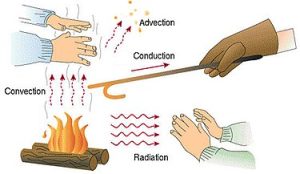Heat Transfer- Conduction Convection & Radiation
What is Heat Transfer?
Heat flow between or within substances occurs through mechanism of conduction, convection and radiation. Heat transfer is a discipline of thermal engineering that concerns the generation, use, conversion, and exchange of thermal energy, i.e. heat between physical systems. Heat transfer is classified into various mechanisms, such as thermal conduction, thermal convection, thermal radiation. Though, these mechanisms have distinct characteristics, yet they often occur simultaneously in the same system.

Mechanism of Heat Transfer
The fundamental modes of heat transfer are:
Conduction
- Also called Diffusion is the transfer of energy between objects that are in physical contact. Heat transfers by molecular activity, as the first molecule is heated, it is speeded up and transferred to adjacent molecule.
- Conduction occurs more easily in solids and liquids, where particles are closer together.
- Conduction is the most significant means of heat transfer within a solid or between solid objects in thermal contact. Fluids, especially gases are less conductive.
- The process of heat transfer from one place to another place without the movement of particles is called conduction, such as when placing a hand on a cold glass of water—heat is conducted from the warm skin to the cold glass,
Convection
- Heat transfer within liquids and gases resulting from the motion of fluid.
- The transfer of energy between an object and its environment, due to fluid motion. The fluid flows from a high temperature location to a low temperature location.
- Bulk motion of fluid enhances heat transfer in many physical situations, such as between a solid surface and the fluid.
- Convection is usually the dominant form of heat transfer in liquids and gases. Although sometimes discussed as a third method of heat transfer, convection is usually used to describe the combined effects of heat conduction within the fluid (diffusion) and heat transference by bulk fluid flow streaming.

Radiation
- It is the transfer of energy by the emission of electromagnetic radiation moving at the speed of light. It doesn’t require medium.
- Radiative heat transfer is the transfer of energy via thermal radiation, i.e., electromagnetic waves. It occurs across any transparent medium (solid or fluid or gas).
- Thermal radiation is emitted by all objects at temperatures above absolute zero, due to random movements of atoms and molecules in matter. Since these atoms and molecules are composed of charged particles (protons and electrons), their movement results in the emission of electromagnetic radiation which carries away energy.
What is Advection?
It refers to the transport mechanism of a fluid from one place to another place, and is dependent on motion and momentum of that fluid. This can be as simple as placing hot water in a bottle and heating a bed.
See also…
WEATHER ELEMENTS- AN OVERVIEW